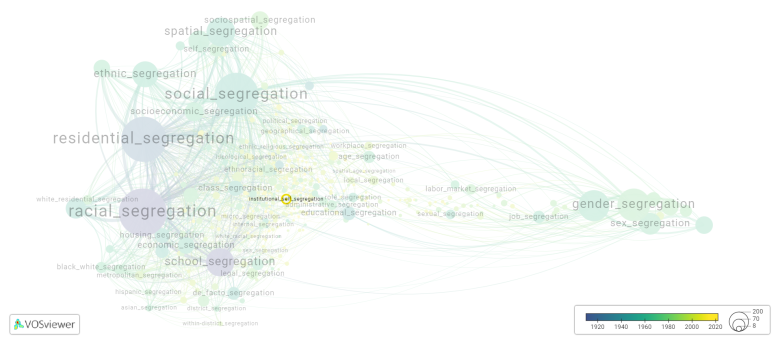Institutional self segregation: Difference between revisions
(Creating page) |
(Creating page) |
||
| (3 intermediate revisions by the same user not shown) | |||
| Line 14: | Line 14: | ||
Efforts to address institutional self-segregation involve promoting equal opportunity, fostering inclusivity, and encouraging cross-cultural interactions. This can be achieved through policies and initiatives that promote diversity and integration, such as affirmative action programs, inclusive curriculum, and cultural exchange programs. Additionally, creating spaces for dialogue and understanding among individuals from different backgrounds can help break down barriers and promote social cohesion. | Efforts to address institutional self-segregation involve promoting equal opportunity, fostering inclusivity, and encouraging cross-cultural interactions. This can be achieved through policies and initiatives that promote diversity and integration, such as affirmative action programs, inclusive curriculum, and cultural exchange programs. Additionally, creating spaces for dialogue and understanding among individuals from different backgrounds can help break down barriers and promote social cohesion. | ||
==See also== | ==See also== | ||
==Related segregation forms== | |||
Institutional self segregation is frequently discussed in the literature with the following segregation forms: | |||
[[racial segregation]] | |||
[[File:institutional_self_segregation.png|780x780px]] | |||
This visualization is based on the study [[Segregation_Wiki:About| The Multidisciplinary Landscape of Segregation Research]]. | |||
For the complete network of interrelated segregation forms, please refer to: | |||
* [https://tinyurl.com/2235lkhw First year of publication] | |||
* [https://tinyurl.com/2d8wg5n3 Louvain clusters] | |||
* [https://tinyurl.com/223udk5r Betweenness centrality] | |||
* [https://tinyurl.com/244d8unz Disciplines in which segregation forms first emerged (Scopus database).] | |||
==References== | ==References== | ||
==Notes== | ==Notes== | ||
Latest revision as of 07:17, 16 October 2024
Date and country of first publication[1][edit | edit source]
2021
United States
Definition[edit | edit source]
Institutional self-segregation refers to the phenomenon where individuals and groups voluntarily separate themselves along racial, ethnic, or social lines within institutions such as schools, workplaces, or communities. This form of segregation can occur due to various factors, including personal preferences, cultural differences, economic disparities, and historical patterns of discrimination and marginalization.
Institutional self-segregation often reflects deep-seated social and structural inequalities. It can manifest as individuals or groups choosing to associate predominantly with people who share their racial or cultural background, limiting social interactions and opportunities for cross-cultural understanding. This can contribute to the perpetuation of stereotypes, prejudices, and discriminatory practices.
There are several factors that contribute to institutional self-segregation. For example, individuals may feel more comfortable or secure within their own cultural or ethnic group, particularly if they have experienced discrimination or marginalization in the past. Additionally, historical factors such as segregationist practices or policies may have led to the formation of distinct communities and neighborhoods.
Institutional self-segregation can have both positive and negative consequences. On one hand, individuals may find solace, support, and a sense of belonging within their own communities. It can also allow for the preservation and celebration of cultural traditions and practices. On the other hand, self-segregation can limit individuals' exposure to diverse perspectives, hinder social integration, reinforce stereotypes, and perpetuate inequalities.
Efforts to address institutional self-segregation involve promoting equal opportunity, fostering inclusivity, and encouraging cross-cultural interactions. This can be achieved through policies and initiatives that promote diversity and integration, such as affirmative action programs, inclusive curriculum, and cultural exchange programs. Additionally, creating spaces for dialogue and understanding among individuals from different backgrounds can help break down barriers and promote social cohesion.
See also[edit | edit source]
Related segregation forms[edit | edit source]
Institutional self segregation is frequently discussed in the literature with the following segregation forms:
This visualization is based on the study The Multidisciplinary Landscape of Segregation Research.
For the complete network of interrelated segregation forms, please refer to:
References[edit | edit source]
Notes[edit | edit source]
- ↑ Date and country of first publication as informed by the Scopus database (December 2023).
At its current state, this definition has been generated by a Large Language Model (LLM) so far without review by an independent researcher or a member of the curating team of segregation experts that keep the Segregation Wiki online. While we strive for accuracy, we cannot guarantee its reliability, completeness and timeliness. Please use this content with caution and verify information as needed. Also, feel free to improve on the definition as you see fit, including the use of references and other informational resources. We value your input in enhancing the quality and accuracy of the definitions of segregation forms collectively offered in the Segregation Wiki ©.
Institutional self segregation appears in the following literature[edit | edit source]
Anicich E.M., Jachimowicz J.M., Osborne M.R., Phillips L.T. (2021). Structuring local environments to avoid racial diversity: Anxiety drives Whites' geographical and institutional self segregation preferences. Journal of Experimental Social Psychology, 95(), -. Academic Press Inc..https://doi.org/10.1016/j.jesp.2021.104117

